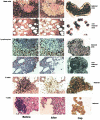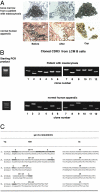Demonstration that mast cells, T cells, and B cells bearing the activating kit mutation D816V occur in clusters within the marrow of patients with mastocytosis
- PMID: 15507672
- PMCID: PMC1867480
- DOI: 10.1016/S1525-1578(10)60529-6
Demonstration that mast cells, T cells, and B cells bearing the activating kit mutation D816V occur in clusters within the marrow of patients with mastocytosis
Abstract
Mastocytosis is characterized by focal heterotypic clusters of mast cells and lymphocytes in the bone marrow and by a somatically acquired activating Kit mutation, D816V. The relationship of the occurrence of this mutation to the heterotypic clusters of mast cells and lymphocytes in bone marrow is unknown. We hypothesized that these two unique features of mastocytosis were related. To explore this hypothesis, laser capture microdissected mast cells, B cells, and T cells, from both lesional and non-lesional areas of bone marrow biopsy tissues from patients with mastocytosis, were examined for the D816V mutation in their DNA, using HinfI restriction digestion of nested PCR products amplified from extracts of dissected cells. The D816V mutation was detected in mast cells, B cells, and T cells from lesional but not non-lesional areas of bone marrow tissues. B cells obtained from lesional areas of tissue were also assessed for clonality and were found to at least represent an oligoclonal population. Thus, mast cells and lymphocytes within focal aggregates in the bone marrow of those with mastocytosis are more frequently positive for the codon 816 activating mutation. Further, the B cell population is oligoclonal, suggesting that clonal proliferation is unlikely to be the basis of clustering.
Figures




Similar articles
-
Systemic mastocytosis associated with chronic idiopathic myelofibrosis: a distinct subtype of systemic mastocytosis associated with a [corrected] clonal hematological non-mast [corrected] cell lineage disorder carrying the activating point mutations KITD816V and JAK2V617F.J Mol Diagn. 2008 Jan;10(1):58-66. doi: 10.2353/jmoldx.2008.070061. Epub 2007 Dec 28. J Mol Diagn. 2008. PMID: 18165278 Free PMC article.
-
Molecular diagnosis of mast cell disorders: a paper from the 2005 William Beaumont Hospital Symposium on Molecular Pathology.J Mol Diagn. 2006 Sep;8(4):412-9. doi: 10.2353/jmoldx.2006.060022. J Mol Diagn. 2006. PMID: 16931579 Free PMC article. Review.
-
Circulating KIT D816V mutation-positive non-mast cells in peripheral blood are characteristic of indolent systemic mastocytosis.Eur J Haematol. 2012 Jul;89(1):42-6. doi: 10.1111/j.1600-0609.2012.01789.x. Epub 2012 Apr 28. Eur J Haematol. 2012. PMID: 22469616
-
Urinary 11β-PGF2α and N-methyl histamine correlate with bone marrow biopsy findings in mast cell disorders.Allergy. 2015 Oct;70(10):1230-8. doi: 10.1111/all.12668. Epub 2015 Jun 24. Allergy. 2015. PMID: 26095439
-
Recent advances in the understanding of mastocytosis: the role of KIT mutations.Br J Haematol. 2007 Jul;138(1):12-30. doi: 10.1111/j.1365-2141.2007.06619.x. Br J Haematol. 2007. PMID: 17555444 Review.
Cited by
-
Pharmacological targeting of the KIT growth factor receptor: a therapeutic consideration for mast cell disorders.Br J Pharmacol. 2008 Aug;154(8):1572-82. doi: 10.1038/bjp.2008.204. Epub 2008 May 26. Br J Pharmacol. 2008. PMID: 18500355 Free PMC article. Review.
-
Recent Advances in the Molecular Biology of Systemic Mastocytosis: Implications for Diagnosis, Prognosis, and Therapy.Int J Mol Sci. 2020 Jun 2;21(11):3987. doi: 10.3390/ijms21113987. Int J Mol Sci. 2020. PMID: 32498255 Free PMC article. Review.
-
Mast cell-mediated and associated disorders in pregnancy: a risky game with an uncertain outcome?Front Immunol. 2014 May 19;5:231. doi: 10.3389/fimmu.2014.00231. eCollection 2014. Front Immunol. 2014. PMID: 24904581 Free PMC article. Review.
-
Detection of the KIT D816V mutation in peripheral blood of systemic mastocytosis: diagnostic implications.Mod Pathol. 2015 Aug;28(8):1138-49. doi: 10.1038/modpathol.2015.72. Epub 2015 Jun 12. Mod Pathol. 2015. PMID: 26067933
-
Comprehensive Analysis of Acquired Genetic Variants and Their Prognostic Impact in Systemic Mastocytosis.Cancers (Basel). 2022 May 18;14(10):2487. doi: 10.3390/cancers14102487. Cancers (Basel). 2022. PMID: 35626091 Free PMC article. Review.
References
-
- Akin C, Jaffe ES, Raffeld M, Kirshenbaum AS, Daley T, Noel P, Metcalfe DD. An immunohistochemical study of the bone marrow lesions of systemic mastocytosis: expression of stem cell factor by lesional mast cells. Am J Clin Pathol. 2002;118:242–247. - PubMed
-
- Furitsu T, Tsujimura T, Tono T, Ikeda H, Kitayama H, Koshimizu U, Sugahara H, Butterfield JH, Ashman LK, Kanayama Y, Matsuzawa Y, Kitamura Y, Kanakura Y. Identification of mutations in the coding sequence of the proto-oncogene c-kit in a human mast cell leukemia cell line causing ligand-independent activation of c-kit product. J Clin Invest. 1993;92:1736–1744. - PMC - PubMed
-
- Nagata H, Worobec AS, Oh CK, Chowdhury BA, Tannenbaum S, Suzuki Y, Metcalfe DD. Identification of a point mutation in the catalytic domain of the protooncogene c-kit in peripheral blood mononuclear cells of patients who have mastocytosis with an associated hematologic disorder. Proc Natl Acad Sci USA. 1995;92:10560–10564. - PMC - PubMed
-
- Akin C, Kirshenbaum AS, Semere T, Worobec AS, Scott LM, Metcalfe DD. Analysis of the surface expression of c-kit and occurrence of the c-kit Asp816Val activating mutation in T cells, B cells, and myelomonocytic cells in patients with mastocytosis. Exp Hematol. 2000;28:140–147. - PubMed
Publication types
MeSH terms
Substances
LinkOut - more resources
Full Text Sources
Molecular Biology Databases

